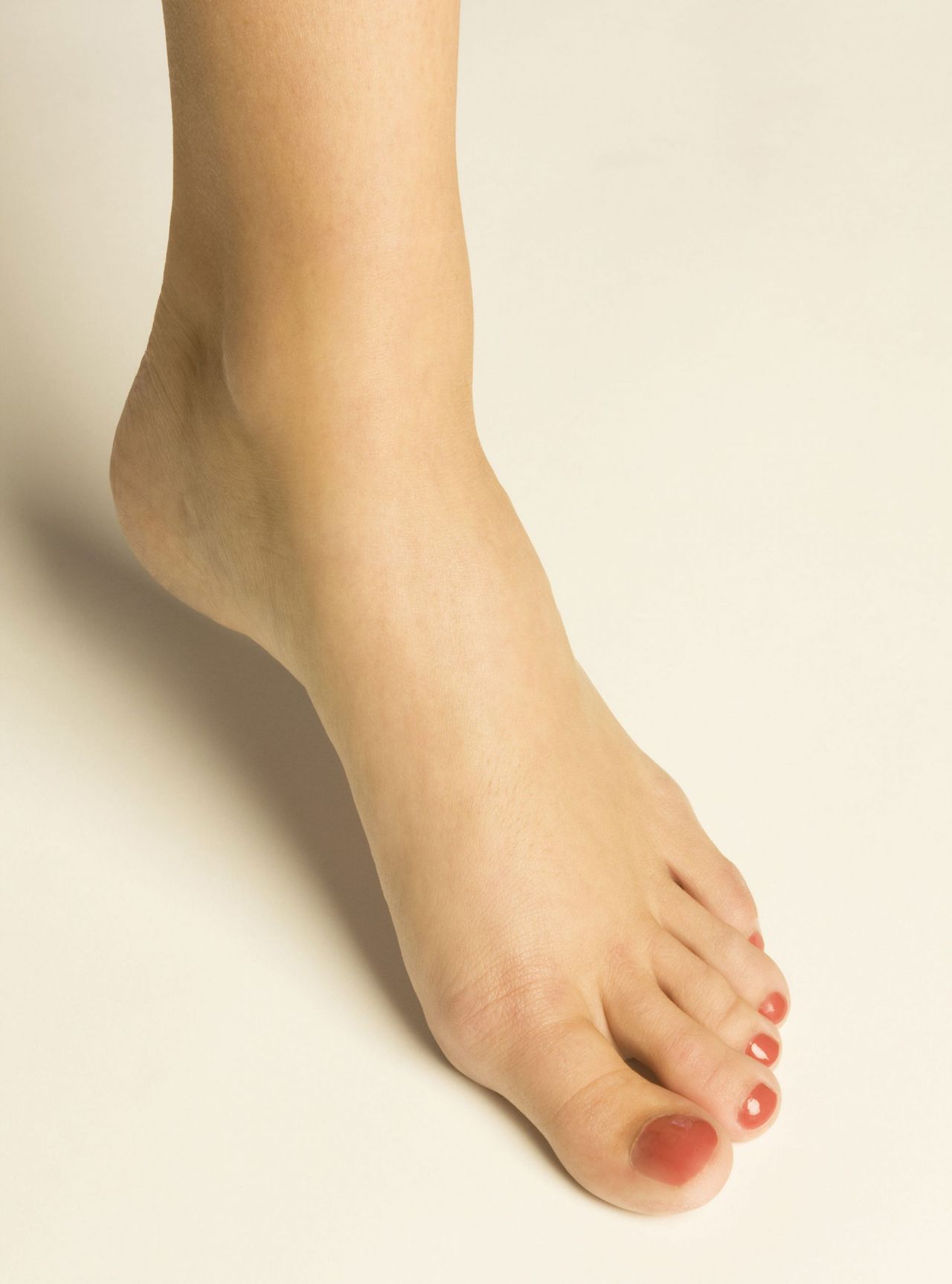Give Your Feet Some TLC

Summer and the sandal wearing that goes with it suddenly has us wanting to take better care of our feet. We've enlisted the experts -Nick Savva, Orthopaedic Foot and Ankle Surgeon, Dorset County Hospital and private clinics at London's Fortius Clinic;Nicholas Masucci, Consultant podiatrist, Newham University Hospital and private clinics in London and Surrey; andLiz Allan, Podiatrist at Perform at The Ageas Bowl in Southampton -to offer advice on common foot problems, showcase solutions and introduce you to treatments that will have even the most painful feet feeling ready to go again.
PAINFUL LUMP ON BIG TOE
Most likely to be...a bunion. This deformity is created when the major joint in the big toe and the bone behind tilt outwards, forcing the toe to turn in and causing pain and swelling. Tight shoes and high heels can exacerbate pain, but don't cause bunions, which in seven out of ten of cases are inherited.
Management...Wear comfortable footwear. Try strivefootwear.com, fitflop.co.uk and keenfootwear.com. Stretching exercises may help. To alleviate pressure and friction further, try gel-based toe separators and spreaders or bunion protectors (from pharmacies).
Next step...Customised insoles (orthotics) can be prescribed or ordered from a podiatrist, either NHS or private. Expect to pay between £70 and £300 depending on the materials. Podiatrists and some GPs give steroid injections, which may relieve pain and inflammation.
Surgical solutions...Incredibly there are more than 100 variations of operation. Metatarsal osteotomy is the most common. It involves removing the bunion, then cutting and resetting the bones, which are fixated with small screws.
Latest Treatment...Minimal invasive "keyhole" surgery, which uses a tiny incision the size of a pencil lead, is becoming increasingly popular. It has a better cosmetic result and recovery time is shorter. Available privately (from £3000) and in some areas on the NHS. Always choose a surgeon with extensive experience of open bunion operations.
Sign up for the woman&home newsletter
Sign up to our free daily email for the latest royal and entertainment news, interesting opinion, expert advice on styling and beauty trends, and no-nonsense guides to the health and wellness questions you want answered.
STIFF, PAINFUL, BIG TOE JOINT
Most likely to be...arthritis of big toe joint. It's caused by the thinning of the cushioning cartilage between the bones and affects one in 40 of us by age 50.
Management...Losing weight if you need to, stretching exercises (see below) tai chi, yoga and ‘physiological' footwear such as MBTs (uk.shop.mbt.com) that rock over the painful joint, may help.
Next step...Over-the-counter pain relievers, orthotics and physiotherapy, plus injections of the joint lubricant, hyaluronic acid (Ostenil), from your GP, orthopaedic surgeon or podiatrist is standard and fairly widely available.
Surgical solutions...The gold standard operation for severe arthritis is arthrodesis (fusion). The joint surface is removed and screws inserted to weld together the bones at the big toe base. It's available on the NHS and privately. Full recovery takes 12 weeks or more.
Latest treatment...Cartiva, an implant of synthetic cartilage, which is also being used to treat arthritis in the thumb. It is mainly available privately (from about £3,200 for one foot; £4,800 for two) but also in some areas on the NHS. The result of a trial this summer may make it more widely available. It takes about 25 minutes and may be done under light sedation and local anesthetic or general anesthetic, and has a relatively pain-free recovery. You can put weight on the joint immediately and, importantly, recover mobility in the toe.
STABBING PAIN IN THE HEEL
Most likely to be...plantar fasciitis, inflammation of the long band of tough connective tissue that runs along the sole of the foot. Common in those aged between 40-60, triggers include being overweight, having flat feet or a high arch, standing a lot, and a tight Achilles tendon in the ankle. Pain is worst after rest. ‘It usually clears on its own but can take up to 18 months,' says Nick Savva.
Management...Rest, painkillers, anti-inflammatory medication and stretching (see below). Avoid flip flops, ballet pumps and other flat shoes - this is one condition where wearing heels, albeit low ones, is advised to alleviate pressure. A podiatrist can prescribe orthotics, which can help by supporting the arch and cushioning the heel. If simpler measures don't help a night splint (a special strap on support that holds your foot at a 90-deree ankle to stretch the fascia) or rigid plastic boots, that do the same job, may help
Surgical solutions...Around one in 20 need a steroid injection, but it doesn't always relieve pain and very occasionally may lead to a fascial tear. Surgery to release the tight tissue may occasionally be advised but is rarely performed.
Latest treatment...Extracorporeal shockwave therapy shoots high-energy soundwaves at the area, which can be uncomfortable but isn't painful. "It triggers the formation of new blood vessels which activate healing," says Mr Savva. Available in a few NHS clinics and privately. £600-800 for three sessions.
FALLEN ARCHES
This is very common in women over 40. Caused by the stretching of the tibialis posterior tendon on the sole of the foot, but the underlying culprit may be proteolytics enzymes, which weaken parts of the tendon, causing the arch to flop. Supportive shoes, orthotics, rest, ice, painkillers and stretches can all help, and you should avoid road running and high-impact sports.
5 stretches your feet will love you for...
1. Golf ball rolls. Sit on a chair both feet flat on the floor. Take a golf ball and roll it under the arch for two minutes. As an alternative use a cold can from the fridge. 2. Toe points: Standing, lift one foot above the floor so it is flat, then move it downwards until your toes are pointing towards the floor. Then flex your foot upwards. Repeat on the other foot. 3. Heel raises: Standing, raise both heels so that you are on the balls of your feet. Hold 10 seconds. Repeat 10 times. 4. Calf stretches: Stand facing a wall with one leg forward and one back and put both hands on the wall at shoulder height. Bend the leg closest to the wall, keeping the back leg straight. Lean into the wall until you feel a stretch in the back of your leg. Hold for 10 seconds. Now swap legs, so the other leg is at the front. Repeat 10 times. 5. Plantar fascia stretch: Sit on a dining chair or on the floor and bend the knee of the affected foot until you can reach your toes. Pull your toes upwards towards you until you feel the stretch in the bottom of your foot. Hold for 20 seconds. Repeat three to five times a day.
-
 Dr Hilary Jones reveals the two 'ideal' exercises for losing weight and keeping it off for good
Dr Hilary Jones reveals the two 'ideal' exercises for losing weight and keeping it off for goodThe doctor appeared on Lorraine to share his tips on how to burn more calories in the gym, outdoors or at home
By Grace Walsh Published
-
 Denise Lewis’ sultry take on the lace trend has convinced us to give it a go at our next special event
Denise Lewis’ sultry take on the lace trend has convinced us to give it a go at our next special eventDame Denise Lewis wore a sensational lace pencil dress to the 2025 MOBO Awards and it's a sophisticated way to wear this trend
By Emma Shacklock Published